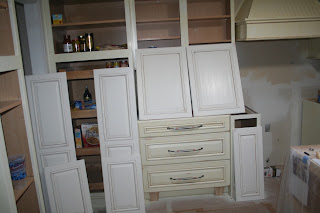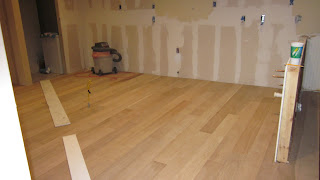So it is time Rafiki. The cabinets are ready to be hung! Huzzah!!! Can you tell I am excited? If you have never hung cabinets before (and I haven't), there are many things you have to think about before you start. And I had to consult with my technical advisor on this one, so it may be more wordy and technical than my normal posts.
In theory, setting kitchen cabinets should be easy: Strike a couple of
level lines, fasten cabinets to the wall, and presto! You have a new
kitchen. Setting cabinets is a tempting DIY project because the
installation principles are basic (isn't that the way they show it on the DIY shows), but the reality—especially in the
old-house world of crooked floors and uneven wall surfaces—is more
complicated. And even brand new houses, as much as we'd like to think they are - aren't perfect.
First, you have to find your highest and lowest point on the floor. As much as we'd like to think so, when slabs are poured, they are NEVER level. I walked in one night and saw Paul with three (yes count them, three) levels on the floor trying to find the highest spot (since the low spots can be shimmed up, but the high spots can't be taken down). Once you have determined that, you measure upward from that line. The bottom of your top cabinets sit 54 inches from that line (normally).
Then you have to check your wall for plumb (and no it is not a fruit). Plumb meaning the vertical line of your wall. (To my husband, houses are living, breathing things which change constantly, and what once was plumb may not be now.) Or in layman's terms, whichever part of your wall sticks out more, that's where the cabinet will set and you will have to shim the others to make the other cabinets sit in a nice straight uniform line from there. And if you live with a perfectionist, like I do, somewhat straight ain't good enough.
At this point, you are probably going, hmhm, maybe I should hire a contractor. Stay with me folks, it gets somewhat better.
Then you "pop" your level line or chalk line to start setting your upper cabinets. It's better to set your upper cabinets first, since you don't want to be crawling over your base cabinets. Locate all of the studs in your wall and mark them for easy access. Then, decide where you want to start and then set a ledger line (normally a piece of straight wood) in order to set the base of your cabinet on while you are setting them. I didn't take a picture of Paul doing this, but here's one off of the internet:

Then, take a deep breath and hoist the first cabinet up there (take everything that you can off and out of the cabinet, it will make it easier to handle). It is REALLY, REALLY important, that that first cabinet be right, because from that cabinet all other cabinets are hung. So, once you get it in, you need to check level and plumb (meaning vertically perfect) and square. And sometimes, in order to get it level, plumb, and square, you may have to stick cedar shims on the backside of the cabinet in order to get it there. Bear in mind that you may have to do this a couple of times. Once it's perfect, then you fasten it to the wall.
After you have gotten the first one right, you hoist up the second one. The tricky part of this one is to make sure the face frames are flush and together, as well as level and plumb. Clamps! Did I mention you can never have enough clamps. Clamp the second cabinet to the first one (this also helps hold it in place so that you aren't killing your back as much). Attach the second cabinet to the first cabinet through the face frame with the screws provided (Paul bought a "quality" countersink bit so that the screws could be hidden and plugged - remember those incidentals). And then again you attach the back to the studs in the wall, checking to be sure they are flush with the wall (shim as needed). And you continue onward until they are all hung. One note, be sure you check the measurements for your range hood, before you call it a day.
Here's a visual of ours
Then, you get to tackle the bottom cabinets. Remember the floor issue, so you need to make sure when you set them in, they are square, plumb and level. So again, keep that package of shims handy. You won't use a board to rest them on since they sit on the floor, but you will need to mark a level line on the wall from the high point in the floor to the cabinet height. Make sure you use a level, so that this line is a true horizontal, it does you no good to have wiggly lines. Again, use your stud finder to find and mark all of the studs on the wall.
Then, take another deep breath and place your base cabinet. Check again for plumb, level and square (especially across the countertop), make whatever adjustments are needed and then screw it into place. Continue with other cabinets until finished.
You also want to make sure you check your measurements for your appliances and sink, as there is nothing worse than getting all of your cabinets in and then the stove, sink or dishwasher not fitting and having to take things apart and put them back together again.
More visuals
Is this everything you need to know about hanging cabinets? NOPE. These are the basics. BUT, if you have questions, comments, etc., feel free to send them to me in the comment box and I'll have Cabinet Master Paul try to answer them. DON'T use Wikipedia.
As with all of our projects we did have one small glitch with our cabinets. Since the pantry was pulled out an extra 1 1/2", we lost 3/16" of the face frame. The cabinet door of the cabinet beside the pantry would not open the full 90 degrees needed (it opened to about 86 degrees). It needed that 3/16". Paul made the mistake of showing it to me and I made him fix it. The fire in his eyes was priceless. When i asked him why he showed it to me in the first place his answer was "I though you would give me a pass on it". So he had to go out to the work shop and cut a shim 1/8" thick by 3/4" wide by 30" long, take down the two cabinets already hung, glue the shim to the cabinet face frame, wood putty it, sanded it smooth and rehang the two cabinets. Would I have made a contractor redo it? You betcha. And, when we moved that cabinet an 1/8th of an inch, it mucked up the measurements for the range hood. So it had to be moved also.
I guess I am more Type A than I thought.
The final reveal.


















































